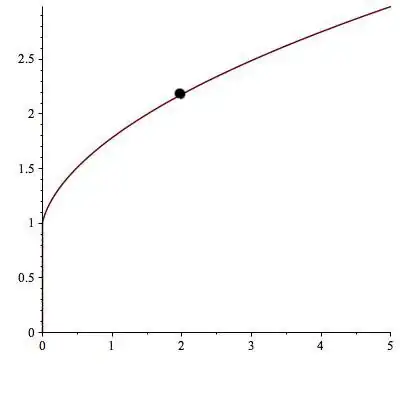With a little look ingenuity you can not only prove convergence, but bracket the limit with arbitrary precision.
Consider the radical
$\sqrt{1+\sqrt{2+\sqrt{4+\sqrt{8+...}}}}$
Let us define
$a_n=\sqrt{1+\sqrt{2+\sqrt{4+\sqrt{8+...+\sqrt{2^{n-1}}}}}}$
Then we have
$a_n^2-1=\sqrt{2+\sqrt{4+\sqrt{8+...+\sqrt{2^{n-1}}}}}$
but also
$\sqrt{2}a_n=(\sqrt{2})(\sqrt{1+\sqrt{2+\sqrt{4+\sqrt{8+...+\sqrt{2^{n-1}}}}}})$
$=\sqrt{2+2\sqrt{2+\sqrt{4+\sqrt{8+...+\sqrt{2^{n-1}}}}}}$
$=\sqrt{2+\sqrt{8+4\sqrt{4+\sqrt{8+...+\sqrt{2^{n-1}}}}}}$
...
$=\sqrt{2+\sqrt{8+\sqrt{64+\sqrt{1024+...+\sqrt{2^{n(n-1)/2}}}}}}$
The radicands in b.c. the expression for $\sqrt{2}a_n$ equal or exceed the corresponding for $a_n^2-1$, and as if to add insult to injury the former also has one more "layer". Clearly this comparison forces:
$a_n^2-1<\sqrt{2}a_n$
$a_n<(\sqrt{6}+\sqrt{2})/2=b_1$
And so the truncations $a_n$ form an increasing VC sequence that is bounded, proving it converges and the limit is less than the number above. Rounding the upper bound up to the next multiple of $0.01$, an accuracy herein used throughout for numerical values, gives a limiting value
$1=a_1<a_{\infty}<b_1<1.94$
But why stop there? Suppose we render our nested radical as
$\sqrt{1+(\color{blue}{\sqrt{2+\sqrt{4+\sqrt{8+...}}}})}$
and focus on the blue portion. By an argument analogous to that used above we find
$\sqrt{2+\sqrt{4+\sqrt{8+...}}}<(\sqrt{10}+\sqrt{2})/2$
Therefore we now render
$b_2=\sqrt{1+(\sqrt{10}+\sqrt{2})/2}<1.82$
$1.55<a_2<a_{\infty}<b_2<1.82$
We can go on like this, adding more iterations to get progressively tighter bounds. It turns out that the tuncatiobs and upper bounds converge to the same limit so arbitrary accuracy is achieved. Here the $b_2$ bound between $1.81$ and $1.82$ is already good to two significant digits (actual value = $1.78$ to the accuracy used here).
